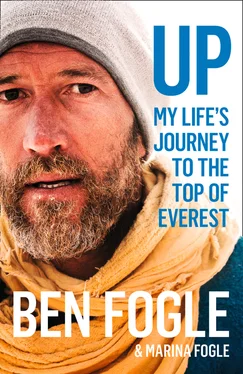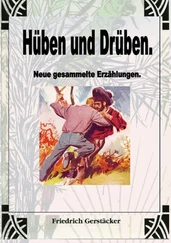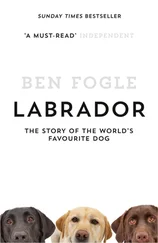It was early January 2018. Kenton and Victoria had gone ahead of me. I thought it would be good for the pair of them to have an extra week to re-bond and connect. We needed absolute trust and confidence in one another, and it was the perfect opportunity for the two of them to spend time together.
I joined them a week later, at the foot of Imja Tse, a 6,000-metre snow peak in the Himalayas of eastern Nepal that is popular with trekkers. It was given the name ‘Island Peak’ by members of the 1953 British Mount Everest expedition, because it is surrounded by a sea of ice. Renamed Imja Tse some 20 years later, it is still called Island Peak by most trekkers and climbers today.
I had spent the previous month at sea-level with my family in the Bahamas. The cold, snowy mountains of Nepal were certainly a shock to the system as I helicoptered from Kathmandu deep into the Khumbu Valley – on the route to Everest herself. Within a day of arriving we were at base camp getting ready to climb another 6,000-metre peak. It was the first time since Bolivia that the three of us had been together in the mountains.
At midnight, we pulled on our safety harness and roped ourselves together. Joining us was a local sherpa called Siddhi. In the chill morning air, we set off up the mountain. The climb was easier than Illimani, but nonetheless we struggled.
About halfway up, Victoria stopped for a rest and she broke. She hit the wall and just couldn’t go on. I was confused and upset, and I didn’t know what we could do. If she was struggling here, then what would happen once we went higher?
Victoria settled on a safe glacial plane while the three of us climbed on towards the summit. We could see her all the way to the top, a tiny silhouette dwarfed by the surrounding snow and ice. Just as the summiting of Illimani had been tempered by worry and guilt, I found myself once again torn between the elation of reaching the summit of Island Peak, getting another step closer to my dream to climb Mount Everest, and my worry over Victoria.
Surprisingly, we never talked about what happened on Island Peak. I’m not sure why. In some ways, I assumed Victoria might have decided to abandon the expedition, but she didn’t. In fact, she seemed to have a renewed sense of determination and Kenton and I admired her resolve.
An astonishing athlete, Victoria had embraced mountaineering effortlessly. I never doubted her physical ability and in fact, I always felt she had a better chance of summiting Everest than I did. But I could see that she struggled with self-doubt. She seemed to listen to a loud inner voice of negativity, which belied her strengths and amazing potential. Kenton and I did our best to reassure her and reinforce how good she was on the mountain, but her own questions about her ability were never far from her mind.
I asked her once whether she had ever been happy with her performance in life.
‘No,’ she replied.
‘Not even when you won a gold medal?’
‘I could have won it better,’ she smiled back.
That’s the thing about Victoria, always scrutinising herself, her own harshest critic.
I hoped that Everest would be a chance to change that. To embrace the unknown and the uncontrollable variables, to give in to the wilderness and silence the inner voice of doubt. We returned to Britain with just a couple of months to make final preparations for the climb.
Shortly after returning from Nepal, my father-in-law announced that after 40 years as a doctor, he had decided to retire. Weekly tennis and golf had kept him in rude health. Fit as a fiddle, he was in great shape. I had been thinking about the trek to Everest Base Camp and decided to invite both my father, Bruce and my father-in-law, Jonathan Hunt. Although I knew the trek would be demanding of two 70-year-olds, I also thought it would be a great opportunity for them to share the experience.
Both Mum and Dad had joined me in various escapades around the world. Dad came out to Ecuador and we visited the Galapagos together, and my mother came out to see me in Costa Rica where we explored the rainforest and even trekked to a smouldering volcano together. They had both come out to La Gomera when James Cracknell and I had set off to row across the Atlantic together, and they had been in Antigua when we arrived two months later.
They have both always supported me 100 per cent. I hate to think of the angst through which I must have put my mother.
In 2017, I invited Dad to join me in Tanzania. He had never visited Africa and I wanted to share with him the wonders of the Serengeti where I was making a documentary about the migration of the wildebeest as they made their way up to the Maasai Mara in Kenya. Dad was with us for 10 days, and it was magical to share with him one of my favourite places on earth.
Dad, at 74, is still working. A veterinary surgeon, he is one of the world’s leading authorities on animal behaviour. He has written nearly a hundred books on dogs and cats and he loves his job. I have often worried about him and wondered whether retirement would be a sensible option, but then his job is who he is. I don’t know what he would do without it.
Dad’s commitment to the clinic and his continuing support of my mother, who was still convalescing at home after her long period in ICU, meant that he couldn’t come on our Everest expedition, but Jonathan surprised me by accepting.
It had been a genuine offer and I hoped that he would add an extra dimension to the trek to Base Camp. While many people are drawn to the Base Camp trek itself, for us it was merely a means to an end. It was an important part of our acclimatisation, but it was incidental.
Kenton had warned us of the risk of sickness and ill health along the route. The 10-day trek to Base Camp is often the breeding ground for illness that can jeopardise the whole mountain climb, from colds and flu bugs to stomach ailments and other lurgies. Jonathan’s 40-year career as a GP meant that we would have a doctor along with us to keep us in good health, as well as me having a family member there. He could be our team doctor.
Victoria and Kenton embraced the idea, and before we knew it, I found myself shopping with my father-in-law for pee bottles and thermal leggings. While having Jonathan along was a great idea, I was worried about the responsibility of taking him. The trek to Base Camp would be a relative walk in the park for those of us heading higher, but for a 70-something the trek could be physically demanding. What if something happened?
I knew how much it meant to Marina for him to accompany us. In a strange way I think it softened her overall worries. The original plan was that Jonathan accompany us to Base Camp where he could stay for a couple of days before heading home.
‘I think he should stay for the whole expedition,’ she said, ‘why doesn’t he become your Base Camp doctor too?’
I think there was a relief for Marina in the knowledge that we would both look out for one another. It made the Everest Expedition more palatable to her.
At the end of our Island Peak climb in Nepal, Victoria and I stayed on to do a couple of days’ fieldwork with the Red Cross. The idea was we would visit some of the people and places supported by the charity.
On the first day, we visited a prosthetic clinic where those who had lost limbs in the earthquake had new limbs fitted. We watched a wheelchair basketball match and met survivors of the disasters, including a young boy who had lost his mother and his leg. We met volunteers who had lost family members and families who had lost their homes and their livelihoods. We visited a blood bank, where I left a pint of my own blood, and we visited rural communities that had lost all their infrastructure.
Victoria and I saw how the Red Cross had helped the Nepalese get back on their feet. They had helped communities rebuild water supplies and sanitation. We were shown how micro-financing had helped families start new businesses and stand on their own two feet. It was moving and humbling. For Victoria in particular, it gave purpose and meaning to our climb and strengthened her resolve. I was always worried that she didn’t have the same motivation to climb Everest that I had.
Читать дальше












